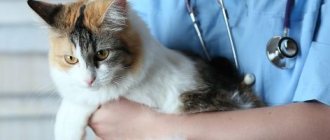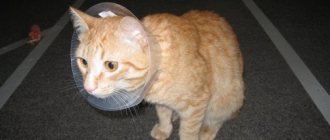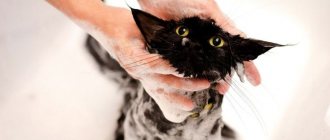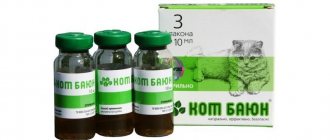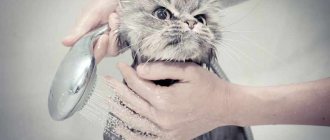Castration of cats is rightfully considered one of the most common veterinary operations. Every year, animal owners are increasingly turning to clinics to de-fertilize their pets, which is understandable. This operation has more advantages. In particular, sterilized animals are healthier and live longer. Some difficulties arise only from the issues of caring for the operated animal. In particular, many breeders do not know when and how to wash a cat after castration.
Why wash your cat after surgery?
In the first hours after anesthesia, the cat may experience involuntary urination or defecation if the owner took pity on the animal and gave food before the operation. The wool gets dirty and gives off an unpleasant odor. In this case, use wet wipes and a sponge, but so that the drops do not fall on the seam.
During this period, an Elizabethan collar is placed around the pet's neck to prevent licking of the wound. Cat saliva lysozyme promotes healing of an open wound exposed to air. Anaerobic (airless) conditions are created inside the seam, necessary for the proliferation of putrefactive microflora. Suppuration develops and the cat has to be treated.
The stitches heal within a week. After they are removed, the surface should not be wetted to avoid complications for another week. Therefore, the collar must be on the pet for at least 14 days.
A blanket is put on the cat to protect the seam from the adverse effects of the environment and accidental wetness. The wound surface is inspected and treated with an antiseptic spray daily. Contaminated areas can be treated with dry shampoo followed by combing. Avoid contact of powder with the surface of the seam.
Be sure to read:
After sterilization, the cat does not eat or drink for several days: what to do, what to feed
Preparing for surgery
The preparation of any unique procedures does not require; it is enough to follow a few rules:
- The pet should not be fed 12 hours before surgery. The last meal should not be dense.
- It is not recommended to give the animal water 1-2 hours before the intervention.
- If the cat is dirty, then 3-4 hours before castration he should be washed, dried and allowed to dry.
- 2 weeks before surgery, the pet is vaccinated or given antiviral serums.
- 5. Before vaccination, deworming should be done and the animal should be rid of fleas and other blood-sucking parasites.
How can you wash an operated cat?
Cats don't need shampoo. Detergents are necessary when it is necessary to exterminate fleas or give the cat a pleasant smell. Therefore, the liquid for the first wash of a cat should consist of 100% warm water.
The cat owner can carry out subsequent bathing at her own discretion, however, in the first months you should pay attention to the condition of the seam. Soap should not be used to bathe cats. It is intended for people whose skin surface pH differs from that of a cat.
Soap dries out the skin and causes cats to lick themselves intensively, which leads to inflammation and the appearance of bald spots (alopecia).
And specialized shampoos are just right. And the fleas will be destroyed at the same time. True, after washing off with a large amount of water, pets remain defenseless against a new attack of ectoparasites.
Baby soap has an intermediate effect between regular soap and cat shampoo. It is less drying and can be used to wash your pet in emergency situations.
Human shampoos should not be used to wash cats. They are not able to rinse the cat's fur well and irritate the skin. Dandruff occurs, hair becomes brittle and the skin is vulnerable to opportunistic bacteria and fungi.
About the operation itself
Two types of operation are possible:
- Castration. It involves the removal of the testes or the cessation of their functioning.
- Sterilization. With this intervention, the testes remain in the body, while they continue to work and produce hormones.
Castration can be carried out using two methods:
- Bloody methods. They involve the removal of the testes and appendages using a surgical incision. The operation is performed under general anesthesia.
- Bloodless methods. With this technique, the testes remain in the scrotum, but the vessels and nerves of the spermatic cord are destroyed. Due to impaired blood supply and innervation, the testes atrophy on their own after some time.
Sterilization in cats is also called a vasectomy. With this intervention, the testes and spermatic cord are not touched, only the vas deferens is cut, so sperm do not enter the urinary canal during ejaculation, so the cat cannot fertilize the female. However, the testes continue to produce testosterone, which is why the pet behaves as before: marks corners, demands the cat, asks to go outside.
How to wash a cat after castration or sterilization
What to do when an animal has just been operated on in a clinic, but it has already gotten dirty. If you do not bathe your pet at this time, the acrid smell of ammonia will spread throughout the apartment and will have to be removed with deodorant. Therefore, in unusual situations, the animal has to be bathed earlier than permitted by the veterinarian.
Be sure to read:
A cat after castration: when he comes to his senses, postoperative care, does behavior change, complications?
It is better when the procedure is carried out together. The assistant carefully holds the cat over the basin. The operator wets the contaminated area with a sponge or damp cloth, carefully removes the dirt, blots it and dries it.
During the washing process, you should not put pressure not only on the seam, but also on the body, so that pain does not arise and the pet does not twitch. Make sure that drops do not fall on the seam, otherwise dry the surface with a napkin.
Castration: why?
In order to avoid typical behavioral problems with an older cat, castration is performed - surgical removal of the gonad. As a result, the cat:
- Stops showing aggression;
- It becomes calmer;
- Starts to play (age does not affect activity);
- Stops leaving marks.
In most cases, castration does not cause any harm to the cat, which is why this method is popular. If the pet is completely healthy, then it quickly recovers from anesthesia. However, for some time it requires additional care.
© shutterstock
Seasonality. Is it possible to wash cats in winter?
During the cold season, temperature changes can affect the weather, sometimes causing colds in cats.
In winter, it is recommended, if possible, to stop washing for a while (until spring).
If, due to the nature of its life, the animal needs regular bathing, you can increase the interval between grooming procedures. In this case, the cat should be washed every 2 months. Such terms are agreed upon for cases where, under normal conditions, the animal is bathed monthly.
Possible postoperative complications
Complications after planned surgical interventions develop extremely rarely and, in most cases, it depends on the individual characteristics of a particular animal.
Main postoperative complications:
- Prolonged post-anesthesia hypothermia. If a cat lies for a long time without moving, and its ears and paws feel cold to the touch, it is necessary to check its body temperature. If the readings are below 37°C, you need to put the cat on a warm heating pad, cover it with any natural piece of fabric and contact your veterinarian for advice.
- Intra-abdominal bleeding. If traces of fresh blood are detected in the suture area or from the vulva, with obvious pain in the abdomen and pallor of the skin, you should immediately take the cat to a veterinary hospital to stop possible bleeding in the abdominal cavity. If internal bleeding is confirmed, then repeated surgery is performed.
- Postoperative hyperthermia. If body temperature is elevated for more than 3 days (above 39°C), it is necessary to consult with a veterinarian or take the cat to an appointment for direct examination by a specialist.
- Redness around the stitch and swelling. This condition of the suture is allowed for 3-5 days, provided that there is no discharge from the wound. After 5 days, both redness and swelling will begin to subside and will completely disappear by the time the stitches are removed.
- Rotting postoperative suture. If the cat's postoperative hygiene measures are not followed, dirt may get into the seam, causing it to fester. It is imperative to show the animal to a doctor. If the prescribed drugs for local treatment do not help eliminate such signs, the doctor will have to remove the stitches, remove the damaged areas of skin around the wound under anesthesia and re-suture it.
- Lump on the abdomen in the suture area. If an enlarged area is detected anywhere around the seam, this is a reason to consult a veterinarian. There are two options for lumps after sterilization - this is post-operative swelling, which may have to be opened, or the growth of granulation tissue (“young” skin), which will go away on its own within a month and a half.
Postoperative area care
To prevent the cat from licking the wounds and gnawing on the stitches, after the cat has recovered from anesthesia, put on a protective cone (Elizabethan collar) for the pet. A similar accessory can be purchased at a veterinary clinic, pet stores, or veterinary pharmacy. If desired, you can make the collar yourself using cardboard, flexible durable plastic or thick fabric. Give preference to durable material, since the cat will try to pull it off in every possible way.
To ensure that the collar does not cause discomfort to the cat or hinder movement, it must be suitable for the pet in size.
You can also protect the postoperative area from licking by using baby diapers (for newborn babies). For convenience, cut a hole for the tail.
How to achieve speedy healing of a postoperative wound?
It's simple. It is necessary to provide the cat with peace and not disturb him unless absolutely necessary. Be sure to isolate your pet from children, if you have any, and explain to them, as well as other members of your family, that there is no need to cuddle and pet the cat during the first days. Let him sleep peacefully. This way tissue regeneration will go much faster.
But some animals do not have a craving for a quiet life. In particular, they strive to lick the operated perineum every now and then, which can end very badly. For example, infection and inflammation of a postoperative wound (which we already indirectly mentioned above). To prevent such sad consequences, you must immediately ask the veterinarian to put a surgical collar on the wayward cat. The pet should wear it for about ten days, until the wounds are completely healed. Washing it at this time, as is easy to understand, is prohibited.
Proper nutrition of the animal plays a major role in accelerating regeneration. On the first day after surgery, chicken broth and low-fat offal are needed. You can use special commercial food for animals recovering from surgery. They contain the optimal amount of proteins, vitamins and microelements, which contribute to the accelerated healing of postoperative wounds.
Adult cat's first bath
If you happen to take an older animal into your home, you need to understand how to bathe it in order to reduce stress. To begin with, it is recommended to familiarize the animal with the environment: it is brought into the room, you can even put it in the bath. Soon after this, you are allowed to wash your pet.
Adult cats that have not previously been in contact with large amounts of water should also be actively distracted from the procedure at first: toys are placed at the bottom of the bath; the more interesting and varied they are, the easier it is to entertain a new friend.
You need to introduce the cat to water gradually: first, pour the liquid to a level of 2-3 cm above the surface of the bathtub or basin. Gradually the amount of liquid is increased. The bathing procedure is standard.
Elimination methods
Regardless of the type of wound infection, be it cases when a cat licks a wound or bacterial contamination of the postoperative area, it is necessary to show the animal to a veterinarian as soon as possible. If you don’t waste time and “catch” the disease at an early stage, it is quite possible to cope with it by prescribing your pet a course of antibiotic therapy. Unfortunately, in cases where the wound is severely inflamed and signs of a necrotic process are observed , a repeat operation is necessary , during which the dead tissue is surgically removed, and the wound channel is completely cleaned and sanitized of exudate.
Be that as it may, in such situations it will take at least two weeks for the cat to fully recover, and during this time the pet requires daily care.
Development of purulent inflammation
Most often, owners of operated animals contact the clinic only when the entire surgical area is swollen, inflamed, and purulent exudate flows profusely from the scrotal cavity. By the way, often licking a post-operative wound is not a “whim” of the cat himself. This happens when a pet is in pain and he tries to cope with the pain reaction in ways available to him.
In cases where your recently neutered cat cannot live without constantly licking the wound, it makes sense to take him to the vet: perhaps your pet does not need a surgical collar, but a course of antibiotics (or even additional surgery).
You should urgently call a specialist in cases where blood is constantly leaking from the scrotum in large volumes. Sometimes this indicates poor-quality ligature placement or other postoperative complications.
In most cases, signs of purulent inflammation become obvious a few hours or a couple of days after surgery. The worst thing is when the cat’s drool (along with hair and other debris) gets into the remote, closed “pockets” of the scrotal bag. In this case, inflammatory processes develop there. In the absence of air and 100% humidity, the pyogenic microflora feels ideal, which is why huge (often multiple) abscesses develop in the scrotum and adjacent tissues.
There are many cases where such abscesses, suddenly bursting, became the cause of the death of an animal from diffuse peritonitis.
Should you wash your cat if you have allergies?
Some cat owners are too early to rejoice, while others should not rush and enthusiastically cross off periodic bathing of their pet from their list of must-dos.
There is a very good reason to give your cat a regular bath, even a short-haired one: allergies. Yours or someone in your household.
Allergy-free cats do not exist in nature, no matter what breeders say, trying to sell an adorable “hypoallergenic” kitten to people.
Every member of the cat family, without exception, produces the FelD1 glycoprotein. This insidious substance gets its name from the abbreviation of the Latin name for the domestic cat - Felis domesticus.
The animal’s sebaceous glands actively work, “charging” everything that the cat’s body is rich in with a dangerous allergen. These are saliva, dandruff, epithelium, sebum, fur, urine, excrement.
The common belief that hairless Sphynx cats do not cause allergies is just a myth. The Sphinx similarly enriches the interior with the products of its vital activity.
Washing your cat weekly will help reduce the number of allergens in the room. When bathing your pet, you need to thoroughly clean the neck: in this place there are many sebaceous glands, and the most allergens.
However, after a couple of days, the level of FelD1 is restored to its previous amount. In the period between baths, anti-allergic wipes (such as Allerpet) can help, which can be used to wipe the animal.
Spaying the female or neutering the male is another method to reduce FelD1 levels, but not eliminate it completely. By excluding the action of sex hormones from the cat’s metabolism, we reduce the production of glycoprotein, which is potentiated by them.
What to do if you have an allergy
The cat must be accustomed to an individual sleeping place, no matter how eager it is to share the bed with you. The contents of the tray must be removed immediately, without waiting for the moisture to evaporate and the solid particles to dry.
Castration of cats depending on age
The most favorable period is from seven months.
The veterinarian will determine how developed the animal is, its organs, whether the cat is physically prepared for the operation, and whether there are any contraindications.
At a young age, cats do not yet have experience of sexual life, so they tolerate the procedure more easily.
You can also castrate an adult pet up to five years old. But old age can lead to complications during the rehabilitation period.
Limitation of mobility.
Healing of wounds after castration takes from 7 to 14 days, so it is recommended that the cat lead a quiet lifestyle during this time - this will allow the stitches to heal better.
Even if the cat feels well, runs and plays with its usual activity, you should not let it outside (at least 7 days). This will prevent excessive physical activity, which could interfere with healing, and will also prevent dirt and dust from entering the surgical wounds.
How often to bathe cats of different breeds
Recommendations:
- Representatives of the Scottish Fold breed are usually not bathed;
- hairless cats produce sebum more intensely, so they need to be washed once a month, but these animals usually love water treatments;
- cats with light hair require more careful care; they can be bathed more often than animals of other colors;
- if the pet is overweight, it is physically difficult for him to lick himself; in this case, it is also allowed to wash the cat monthly.
What you need to bathe cats
You should not purchase too many accessories and cosmetics. All you need to do is prepare everything you need:
- choose what to wash your pet with: you will need a special shampoo for animals, because... when using products intended for caring for the human body and hair, cats often develop dandruff and ulcers may form;
- the towel must be separate;
- When you need to fight fleas, buy anti-parasite shampoo.
Tip: If you don’t have a suitable cat fur care product on hand, you can use baby soap or shampoo once.
Wound infections caused by licking
The main consequence of “rash” licking a wound is the development of wound infection. It is necessary to monitor your pet and notice in time signs indicating the presence of an inflammatory process.
The essence of the pathology is the proliferation of pathogenic and conditionally pathogenic microflora in the wound area. Even in the mildest cases, the presence of infection significantly slows down the healing process. The main signs that something is wrong are redness, swelling and a significant increase in local temperature. But this does not apply to cases where only two to three hours have passed after the operation.
If purulent discharge appears, you should immediately contact a veterinarian, regardless of how long ago the castration was performed. The consequences of delay are severe, including the death of the pet.
How to bathe cats correctly
They start with the preparatory stage. First, the animal's claws are trimmed. If your pet tolerates exposure to water well, you can immediately proceed to hygiene procedures. In other cases, you need to protect yourself by removing the cat's claws. It is better to feed the animal after water procedures, as vomiting may occur due to stress.
Further actions:
- There should be no bottles or small household appliances (hair dryer, etc.) nearby. Everything is removed so as not to create a dangerous situation (the pet may break out when it is washed).
- You need to pour warm water (+37°C) into the container. A sufficient volume of liquid is a few centimeters above the bottom. It is not recommended to completely immerse your pet in water; you need to water it from a ladle.
- You should put a mat or towel on the bottom, as your paws will slip in the water.
- There is no need to securely restrain your pet. Such actions are an alarm signal. It is recommended to hold the animal firmly, but at the same time gently.
- While bathing, you need to constantly talk to your cat. A calm, confident, but at the same time gentle voice will calm her down.
- Use a small amount of shampoo. First, apply to the body and paws, gently lather the fur. The head is washed last, because water can get into the ears, and this will lead to undesirable consequences (diseases).
- You should wash off the shampoo with your hands, and not from the shower: take water with your palms.
- Remove excess moisture when bathing is finished. At the same time, lightly squeeze out the fur in areas where there is more of it: paws, chest, tail.
- The pet is wrapped in a towel and taken out of the bathroom. The air temperature at home must be high enough (+22°C or more), otherwise the animal may get sick.
You need to give your pet the opportunity to clean itself up on its own. You should not dry the coat with a towel or blow dry it.
Tip: It is not recommended to shower your cat while bathing. These sensations will be new to him, and the loud sound of water will increase his fear.
General information
The timing of “washing” largely depends on the type of castration. And, contrary to popular belief, there are several of them:
- First, standard surgical castration. In this case, the animal's scrotum is opened and the testes are excised.
- Secondly, chemical. In this case, substances that suppress the sexual function of the animal are injected directly into the gonads.
- Thirdly, medication. A cartridge with medications is sewn under the cat's skin. The latter, gradually released, suppress the pet’s libido over time.
- Fourthly, radiation. This technique involves irradiating the testes under a source of directed gamma radiation.
As you might guess, in the last three cases no surgical intervention is required; the animal’s scrotum remains completely intact. Accordingly, you can wash your pet immediately after surgery (of course, ideally you need to wait at least one day). But after a surgical operation, such “liberties” are unacceptable; the waiting period increases several times.
Tests and vaccinations
In order for a cat to be admitted to surgery without any problems, the following medical certificates must be provided:
- the result of a general blood test;
- blood biochemistry results"
- urine test results;
- a certificate from a cardiologist about the state of the cardiovascular system (for “aged” cats and animals suffering from obesity).
Since castration takes place under general anesthesia, anesthesia can provoke an increased load on the heart, therefore, in the presence of any cardiac pathologies, sterilization of males is strictly contraindicated.
The tailed patient, like a person, needs to be tested before surgery
Kitten's first bath
The risk of developing colds due to temperature changes in children is much higher. For this reason, negative factors are excluded: drafts, cold air at home.
It is recommended to wait until the teeth are completely replaced. After this, you can wash the kitten, but wait an additional 2 weeks. The sequence of actions is the same as when bathing older pets.
First you need to show the kitten that water is not dangerous:
- the animal is transferred to a small container, only the paws are wet for now, and the rest of the body can be washed when the baby gets used to the new environment;
- To distract the kitten, they leave toys, blow bubbles for the same purpose, or perform other entertaining tricks.
